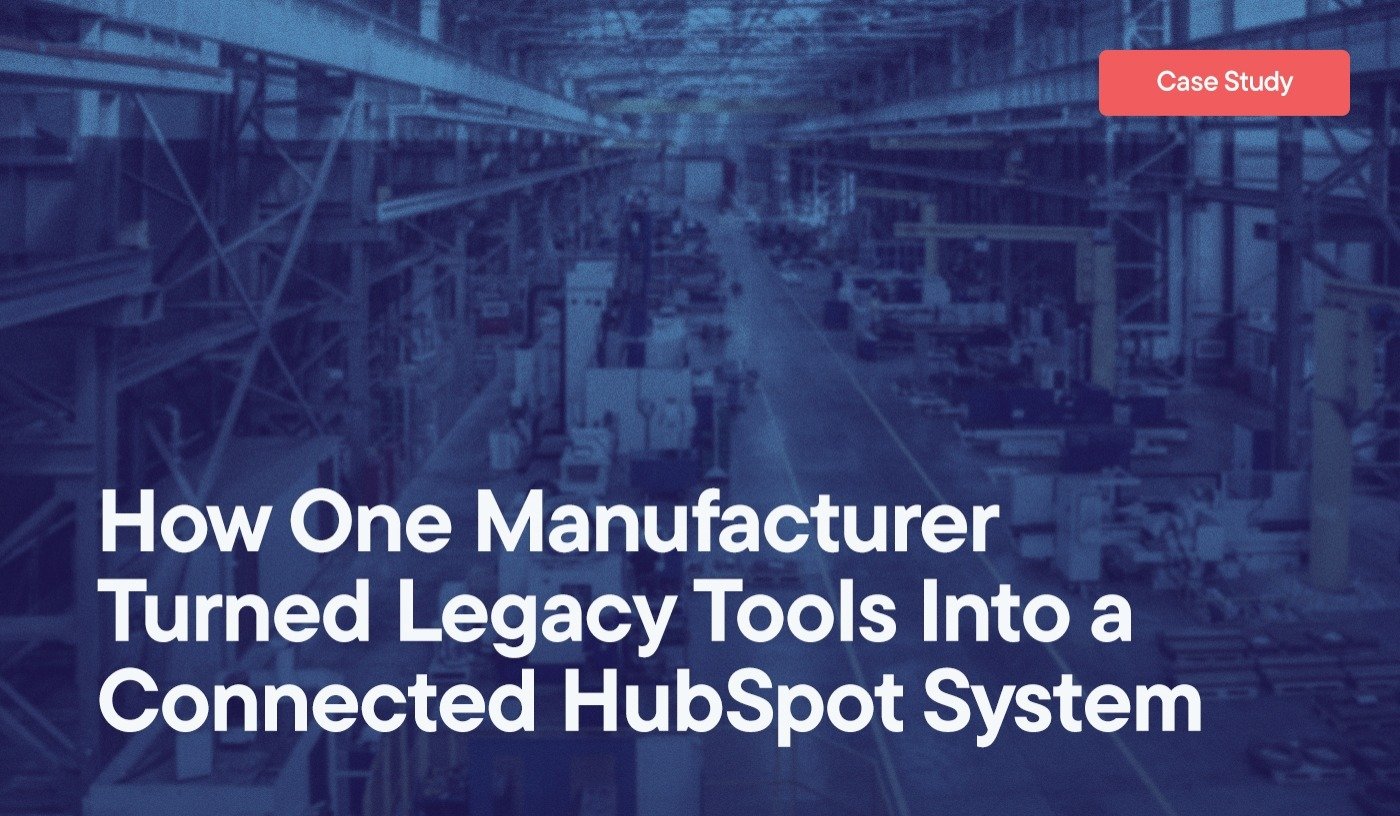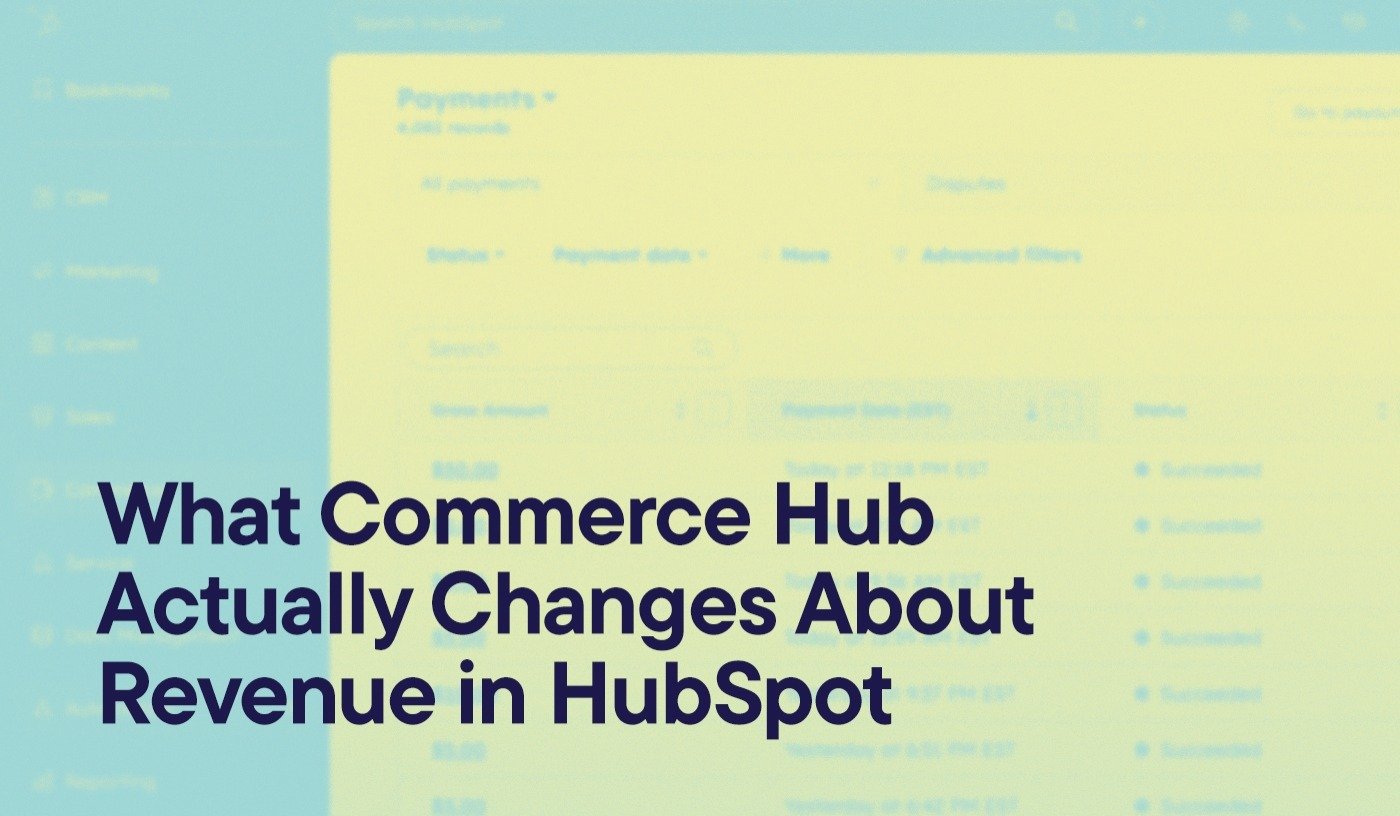A precision manufacturer came to us with a familiar challenge: their operational systems worked well on their own, but not together. Sales, service, and operations each had tools that did their jobs, yet every cross-team interaction created friction.
Here’s what we built to change that.
Custom Integration Between Global Shop and HubSpot ERP
Their parts inventory lived in Global Shop—a system their operations team had refined over years of production use. Replacing it wasn’t the answer. Connecting it was.
We built a bidirectional integration that keeps data synced between Global Shop and HubSpot in real time. Sales reps can now check live inventory during customer calls without leaving the CRM. When quantities change in either system, both update automatically, and workflows trigger based on inventory status.
This wasn’t a simple API connection. Global Shop’s legacy architecture doesn’t support webhooks or real-time change notifications, so we built a custom polling framework for simultaneous updates, error handling, performance optimization, and continuous monitoring.
Sales Hub Implementation
We configured Sales Hub around the way they actually sell, not around default SaaS templates. Custom pipeline stages reflect their manufacturing process. Deal properties capture specifications that matter for quoting—dimensions, materials, tolerances, quantities. Workflows automate follow-ups. Email templates and sequences standardize communication. Dashboards provide leadership with pipeline visibility they never had before.
Service Hub Deployment
We introduced a ticketing system that pulls requests from forms, email, and chat into one centralized dashboard. Automated routing sends tickets to the right team based on issue type. The knowledge base answers common questions, while post-resolution surveys capture feedback automatically. Dashboards now track performance against SLAs and customer satisfaction metrics.
Website Rebuild on CMS Hub
We rebuilt their site from the ground up—more than 30 pages showcasing capabilities (metal forming, laser cutting, fabrication, welding), materials expertise (from aluminum to carbon steel), and industry applications. The result was a modern, responsive, technically optimized site with SEO foundations and automated workflows for everything from career applications to contact forms.
Content Marketing Foundation
We created a sustainable content engine to showcase expertise and capture search demand. Four pillar blog posts—covering the manufacturing process, comparing production methods, tackling complex geometries, and guiding material selection—anchor their organic strategy. Each targets a distinct stage of the buyer journey, turning technical expertise into discoverable authority.
The Problem We Actually Solved
Before implementation, sales reps had two poor options when customers asked about part availability: put the caller on hold to check an antiquated ERP, or make a guess and promise to confirm later. Neither built confidence, and both created unnecessary follow-up.
Service requests lived in inboxes with no visibility. Pipeline tracking was manual. Leadership lacked clear reporting. The website undersold their technical depth. Marketing drove zero inbound interest.
Most agencies would have told them to abandon their existing tech stack and rebuild everything in HubSpot. That might look cleaner on paper, but it would have erased years of institutional knowledge.
We took a different approach: connect what worked, replace what didn’t, and eliminate friction everywhere else.
Principle: Preserve what functions. Connect what’s isolated.
What Makes the Technical Work Different
Integrating Global Shop wasn’t about convenience—it was about reliability under pressure. Sales reps needed accurate data in live conversations, which meant a simple API sync wasn’t enough.
We built a system that detects changes and recovers automatically from connection errors. The integration is monitored continuously for performance and data accuracy.
Eighteen months in, it’s still stable. When new scenarios appear—and they always do—we adapt and strengthen the system. That’s the difference between a demo and a dependable foundation.
Everything else followed proven HubSpot architecture, tuned for manufacturing: pipeline stages mapped to real sales milestones, deal properties capturing production details, and workflows built around genuine customer cadence.
What Changed Operationally
Before
- Reps toggled between systems mid-call
- Service requests buried in inboxes
- Manual follow-ups and reporting
- Outdated website that failed to showcase expertise
- No inbound marketing or organic visibility
After
- Live inventory visible directly in HubSpot records
- Tickets routed and tracked automatically
- Routine communications handled by automation
- Dashboards showing performance and trends in real time
- A modern website generating qualified inbound leads
Same people. Better infrastructure. Fewer steps between question and answer.
Connect Multiple Platforms Seamlessly
Is a HubSpot Integration Right for Your Business?
Explore Custom Integration Solutions arrow_forwardWhy This Takes Time
Implementation is only the beginning. Real-world use reveals what no requirements document ever can: unplanned dependencies, edge cases, and new opportunities.
Good implementation means building, refining, and teaching. It means fixing what doesn’t work as intended, improving what does, and keeping the system aligned with how the business evolves. That’s not fragility—it’s how strong systems mature.
Three Principles That Made It Work
Preserve what’s functional: Legacy systems often work for a reason. Replace only what’s broken and connect what’s proven.
Automate what’s repetitive: Let the system handle updates and notifications so your people can focus on customers and decisions that require judgment.
Build for independence: The client should own their systems day to day. Our role is to handle the complex work and guide continuous improvement.
Common Integration Challenges in Manufacturing
- Inventory and quoting tools that don’t connect to CRM (Sheets, Excel, Access, calculators, BOM trackers)
- Legacy ERPs or MES platforms without modern APIs
- Workflows that require visibility across sales, service, and production
- Fragmented data preventing accurate reporting
Different industries have their nuances, but the pattern is the same: understand how people actually work, preserve what works well, and connect everything else.
Why Most Agencies Would Have Said No
Most HubSpot partners are built for clean, cloud-native SaaS environments. Manufacturing isn’t that. Its systems are older, interdependent, and mission-critical.
Building reliable integrations in that environment takes engineering expertise, operational empathy, and long-term commitment—qualities not found in one-size-fits-all implementations. That’s where Hypha specializes: turning complex, legacy operations into connected, modern ecosystems.
Let’s Have a Straightforward Conversation
If your sales team still switches systems mid-call or your growth depends on manual workarounds, you don’t need a full rebuild. You need integration that respects what’s already working and scales with your operation.
Contact a Hypha expert to talk about where friction exists, what’s possible, and what the right path forward looks like.




